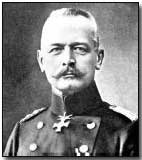Primary Documents - The Siege of Antwerp by Erich von Falkenhayn, October 1914
 Reproduced below is a
victory proclamation announcing the end of the
siege of Antwerp in October
1914 by freshly installed German Army Chief of Staff
Erich
von Falkenhayn. Falkenhayn lost no opportunity in his
proclamation to ridicule the efforts of the British marine brigade sent to
Antwerp to assist in the Belgian defence.
Reproduced below is a
victory proclamation announcing the end of the
siege of Antwerp in October
1914 by freshly installed German Army Chief of Staff
Erich
von Falkenhayn. Falkenhayn lost no opportunity in his
proclamation to ridicule the efforts of the British marine brigade sent to
Antwerp to assist in the Belgian defence.
Click here to read a British summary of the siege by Arthur Conan Doyle; click here to read another by Winston Churchill, who played a key role in despatching British marines to Antwerp; and click here to read a Belgian view.
The Capture of Antwerp
by Erich von Falkenhayn
Great Headquarters, October 10th
After a siege of only twelve days, Antwerp has fallen into our hands.
On September 28th the first shot was fired against the forts of the outer lines. On October 1st the first forts were taken by storm, on October 6th and 7th the strongly embanked Nethe entrenchments, for the most part four hundred meters wide, were overcome.
On October 7th the bombardment of the town was announced in accordance with the Hague agreement. As the commandant declared that he would be answerable for the bombardment, it began at midnight from October 7th to 8th.
At the same time the attack upon the inner forts began.
Early in the morning of October 9th the forts of the inner lines were taken, and on the afternoon of October 9th the city could be occupied without serious resistance.
The probably very strong garrison had at first defended itself very bravely. But as it finally did not feel itself equal to the assault of our infantry and the marine division, as well as to the effectiveness of our powerful artillery, it had fled in complete disorganization.
Among the garrison there was also an English marine brigade which had just lately arrived. According to English newspaper reports it was to form the backbone of the defence.
The degree of disorganization of the English and Belgian troops is indicated by the fact that the negotiations for the surrender had to be carried on with the mayor - as no military authorities were to be found.
The complete surrender was confirmed on October 10th by the chief-of-staff of the hitherto existing government of Antwerp.
The last forts, which had not as yet surrendered, were occupied by our troops. The number of prisoners cannot yet be estimated. Many Belgian and English soldiers have fled to Holland, where they will be interned. Vast supplies of all kinds have been captured.
Source: Source Records of the Great War, Vol. II, ed. Charles F. Horne, National Alumni 1923
Observation balloons were referred to as 'sausages'.
- Did you know?
